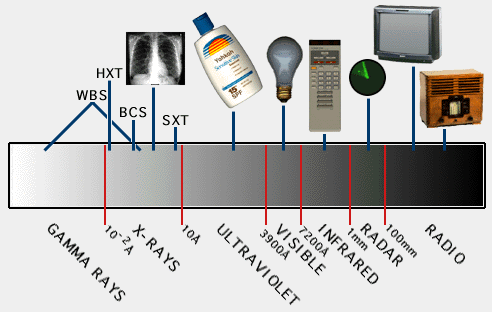The Electromagnetic Spectrum
|
|---|

| | A cartoon of the solar spectrum showing the range of radiation
that the Sun emits.
In addition, the common names for certain bands of the electromagnetic
spectrum are listed and familiar objects that use or block (sunscreen)
radiation from that particular band of the spectrum are shown. Also noted,
are the four Yohkoh instruments and the regions of the high energy part of
the spectrum that each instrument records.
|
|
Our cartoon of the electromagnetic spectrum covers a huge range of in
wavelengths and energy. Perhaps the simplest way to describe the spectrum
and the differences between the various bands (e.g. radio, visible, x-ray,
etc.) is to think of light as a wave-like phenomenon. As these waves
travel they carry their energy with them much like ocean waves which
deposit their energy at the beach by moving sand around (note
ocean waves are not electromagnetic waves). The electromagnetic waves
which have crest spaced far apart are low energy waves and those with
crest spaced close together are high energy waves. The most energetic
in our cartoon are the gamma rays and the lowest energy waves are the
radio waves.
Visible light which makes up only a very thin slice of the whole
electrodynmagnetic spectrum (note the wavelength scale in our cartoon is not
regular) is a very important part of the electromagnetic spectrum.
The unique aspect of visible light is that it is the only part of the
electromagnetic spectrum that our unaided eyes can see. Furthermore, our
eyes are fairly sensitive to this part of the spectrum as we perceive
the longest wavelength of visible light as red and the shortest as violet.
When Sunlight passes thru a piece of cut glass or a prism we see a
rainbow of colors, sunlight broken into its component colors for the
the visible part of the solar spectrum.
The Sun emits at all the wavelengths bands shown in our cartoon, with
the visible part of the complete spectrum being only part we can see
without the aid of other instruments, such as the instruments onboard
the Yohkoh satellite.Since the Sun emits a very wide band of radiation, it is interesting to
compare views of the Sun obtained from different spectral bands. When
one does this they find that the Sun has many different looks (or
faces). Click here to see some of those different views.

